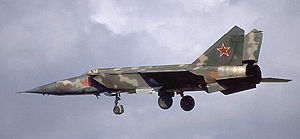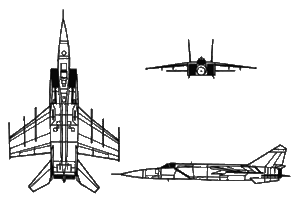Mikoyan-Gurevich MiG-25
| MiG-25 | |
|---|---|
 |
|
| Role | Interceptor/Reconnaissance |
| Manufacturer | Mikoyan-Gurevich OKB |
| First flight | 6 March 1964 |
| Introduced | 1970 |
| Status | Limited active service |
| Primary users | Russian Air Force Algerian Air Force Syrian Air Force Armenian Air Force |
| Number built | 1,190 |
| Variants | Mikoyan MiG-31 |
The Mikoyan-Gurevich MiG-25 (Russian: МиГ-25) (NATO reporting name "Foxbat") is a very high-speed interceptor and reconnaissance/bomber aircraft designed by the Soviet Union's Mikoyan-Gurevich bureau. First flown as a prototype in 1964, it entered service in 1970. With a top speed of Mach 3.2, a powerful radar and four air-to-air missiles, the MiG-25 worried Western observers and prompted development of the F-15 Eagle.
The aircraft's true capabilities were not revealed to the west until 1976 when Viktor Belenko, a Soviet MiG-25 pilot, defected to Japan. Subsequent analysis revealed a simple-yet-functional design with vacuum-tube electronics, two massive turbojet engines, and sparing use of advanced materials such as titanium. The MiG-25 series had a production run of 1,190 aircraft.[1] The MiG-25 flew with a number of Soviet allies and former Soviet republics and it remains in limited service in Russia and several other nations.
Contents |
Development

The development of the MiG-25 began in the 1950s, paralleling American efforts to develop a Mach 3 bomber and interceptor aircraft, including the experimental XB-70 Valkyrie, the XF-103 Thunderwarrior, the Lockheed YF-12, and the XF-108 Rapier. A variety of roles were considered for the prospective aircraft, including cruise missile carriers and even a small five to seven-passenger supersonic transport, but the main objective was a high-altitude reconnaissance aircraft and heavy interceptor.
The Mikoyan-Gurevich OKB accepted the assignment effective 10 March 1961, carrying the bureau designation "Ye-155" (or "Е-155"). Although the XB-70 had been cancelled by the time a Ye-155 prototype was produced, the proposed design was still viewed as a useful addition to the PVO Strany air defense force for use against reconnaissance targets like the SR-71 Blackbird.
Because of the thermal stresses incurred in flight above Mach 2, the MiG-25 could not be constructed with traditional aluminium alloys. Lockheed had utilised titanium for their YF-12 and SR-71 series aircraft and North American used a honeycombed steel material for the XB-70; both companies struggled in employing these advanced materials. Mikoyan-Gurevich OKB constructed the MiG-25 largely from nickel alloy ("Inconel") steel, but used a small amount of titanium and aluminum alloys in areas particularly susceptible to high aerodynamic drag. The steel components of the MiG-25 were formed by a combination of spot-welding, automatic machine welding and hand arc welding methods. Initially there was concern that jolts from landing would cause the metal welds to crack but this proved not to be the case, and any cracks that did develop in service were easily welded in the field.
The first prototype was a reconnaissance variant, designated "Ye-155-R1", and made its first flight on 6 March 1964. The first flight of the interceptor prototype, "Ye-155-P1", took place on 9 September 1964. Development, which represented a major step forward in Soviet aerodynamics, engineering and metallurgy, took several more years to complete. In the meantime several prototypes, under the cover designation "Ye-266" (or "Е-266"), made a series of record-setting flights in 1965, 1966, and 1967.
Series production of the two initial variants, designated MiG-25P ('Foxbat-A') (interceptor) and MiG-25R ('Foxbat-B') (reconnaissance), began in 1969. The MiG-25R entered Soviet Air Force (VVS) service almost immediately, but the service entry of the MiG-25P with the PVO was delayed until 1972. A non-combat trainer variant was also developed for each version, the MiG-25PU ('Foxbat-C') and MiG-25RU, respectively. The MiG-25R evolved several subsequent derivatives, including the MiG-25RB reconnaissance-bomber, the MiG-25RBS and MiG-25RBSh with side-looking airborne radar (SLAR), the MiG-25RBK and MiG-25RBF ELINT aircraft ('Foxbat-D'), and the MiG-25BM ('Foxbat-F') SEAD variant, carrying four Raduga Kh-58 (NATO reporting name AS-11 'Kilter') anti-radiation missiles.
The MiG-25 was capable of high performance, including a maximum speed of Mach 3.2 and a ceiling of 90,000 ft (27,000 m), although on Aug. 31, 1977, an E-266M, a specially modified Foxbat, flown by MiG OKB Chief Test Pilot Alexander Fedotov, set the recognized absolute altitude record for a jet aircraft under its own power, reaching 123,523.62 ft (37,650 m) at Podmoskovnoye, USSR in a brief zoom climb.[2] The record is the only recognized absolute record not held by a pilot from the United States.[3] Although intended for intercepting or threatening high-altitude, high-speed aircraft the MiG-25's maneuverability, range, and close combat potential were extremely limited. Even its high speed was problematic: although sufficient thrust was available to reach Mach 3.2, a limit of Mach 2.8 had to be imposed as the turbines tended to overspeed and overheat at higher speeds, possibly damaging them beyond repair.[4][5][6][7][8]
Despite these limitations, inaccurate intelligence analyses and several false assumptions caused a panic in the West, where it was initially believed that the MiG-25 was actually an agile air-combat fighter rather than a stand-off interceptor. In response, the United States launched an ambitious new program, which resulted in the McDonnell-Douglas F-15 Eagle.
Design description

A true understanding of the strengths and failings of the MiG-25 by the West came on 6 September 1976, when a PVO pilot, Lt. Viktor Belenko, defected to the West, landing his MiG-25P at Hakodate Airport in Japan. It was carefully dismantled and analyzed by the Foreign Technology Division (now the National Air and Space Intelligence Center) of the United States Air Force, at the Wright-Patterson Air Force Base. After 67 days, the aircraft was returned to the Soviets in pieces. The analysis showed some surprising facts:
- Belenko's particular aircraft was brand new, representing the very latest Soviet technology.
- The aircraft was assembled very quickly, and was essentially built around its massive Tumansky R-15(B) turbojets.
- Welding was done by hand and construction was relatively crude. As in many Soviet aircraft, rivet heads were left exposed in areas that would not adversely affect aerodynamic drag.
- The aircraft was built of a nickel-steel alloy and not titanium as was assumed (though some titanium was used in heat-critical areas). The steel construction contributed to the craft's massive 64,000 lb (29,000 kg) unarmed weight.
- The majority of the on-board avionics were based on vacuum-tube technology, not solid-state electronics. Seemingly obsolete, vacuum tubes were actually more tolerant of temperature extremes, thereby removing the need for providing complex environmental controls inside the avionics bays. In addition, the vacuum tubes were easy to replace in remote northern airfields where sophisticated transistor parts may not have been readily available. As with most Soviet aircraft, the MiG-25 was designed to be as rugged as possible. Also, the use of vacuum tubes makes the aircraft's systems more resistant to an electromagnetic pulse, for example after a nuclear blast.
- Thanks to the use of vacuum tubes, the MiG-25P's original Smerch-A (Tornado, NATO reporting name 'Foxfire') radar had enormous power — about 600 kilowatts.
- The airspeed indicator was redlined at Mach 2.8, with typical intercept speeds near Mach 2.5 in order to extend the service life of the engines. An Egyptian MiG-25 was tracked flying over Israel at Mach 3.2 in 1973, but the flight had resulted in the destruction of its engines.[9]
- Maximum acceleration (g-load) rating was just 2.2 g (21.6 m/s²) with full fuel tanks, with an absolute limit of 4.5 g (44.1 m/s²). One MiG-25 withstood an inadvertent 11.5 g (112.8 m/s²) pull during low-altitude dogfight training, but the resulting deformation damaged the airframe beyond repair.[10]
- Combat radius was 186 miles (300 km), and maximum range on internal fuel (at subsonic speeds) was only 744 miles (1,200 km). In fact, Belenko had only just reached Japan without running out of fuel; without sufficient fuel for a carefully planned landing, he narrowly missed a commercial airliner taking off, and overran the available runway on landing.
As the result of Belenko's defection and the compromise of the MiG-25P's radar and missile systems, beginning in 1978 the Soviets developed an advanced version, the MiG-25PD ('Foxbat-E'), with a new RP-25 Saphir look-down/shoot-down radar, infrared search and track (IRST) system, and more powerful engines. About 370 earlier MiG-25Ps were converted to this standard and redesignated MiG-25PDS.
About 1,186 MiG-25s were produced before production ended in 1984, and the type was exported to Algeria, Bulgaria (3 MiG-25R and 1 MiG-25RU until 1992), India (until 2006), Iraq, Libya, and Syria. Modest numbers remain in service.
Operational service
Before entering operational service, four MiG-25Rs were temporarily in service with Egyptian Air Force in 1971 under the cover designation of "X-500". All four had EAF markings. They flew over Israel in pairs roughly 20 times. In 1973, an Egyptian MiG-25 was clocked at Mach 3.2 while being chased by Israeli F-4Es.[9] The Israeli Air Force found it impossible to intercept them, even though Israeli intelligence generally knew when the overflights were scheduled. The MiG-25Rs went back home in 1972, though reconnaissance Foxbats were sent back to Egypt in October 1973, after the Yom Kippur War, and remained there into 1974.[11] The Israeli Air Force did not have the capability to intercept MiG-25s until it received the F-15 Eagle.
Col. Aleksandr V. Drobyshevsky, confirmed that at least one Soviet pilot, in the USSR's MiG-25 "Foxbat" aircraft, flew recon missions from Egypt into Israel in 1967, just prior to the Six Day War.[12]
The MiG-25 was in service with the Iraqi Air Force during the Iran–Iraq War, but its combat record is unclear.
During the Persian Gulf War, a US Navy F/A-18 piloted by Lt Cdr Scott Speicher was shot down on the first night of the war by air-to-air missile[13] fired most likely by a MiG-25.[14] The kill was reportedly made with a R-40DT missile fired from a MiG-25PDS flown by Lt. Zuhair Dawood of the 84th squadron of the IrAF.[15]
In another incident, an Iraqi MiG-25PD, after eluding eight U.S. Air Force F-15s, fired three missiles at EF-111 Raven electronic warfare aircraft, forcing them to abort their mission. This may have led to the later loss of an F-15 to surface-to-air missiles, due to the lack of electronic jamming.[16]
In yet another incident, two MiG-25s approached a pair of F-15s, fired missiles (which were evaded by the F-15s), and then outran the American fighters. Two more F-15s joined the pursuit, and a total of ten air-to-air missiles were fired at the MiG-25s, though none reached them.[17] According to the same sources, at least one F-111 was also forced to abort its mission by a MiG-25 on the first 24 hours of hostilities, during an air raid over Tikrit.[18]
Two MiG-25s were shot down by USAF F-15Cs during the Gulf War. After the war, in 1992, a U.S. F-16 downed a MiG-25 that violated the no-fly zone in southern Iraq.
In May 1997 an Indian Air Force MiG-25RB was detected flying faster than Mach 3 at least 65,000 ft, over Pakistani territory. Reportedly this was a deliberate attempt by the Indian Air Force to demonstrate that the capabilities of the MiG-25 could not be countered by the Pakistani Air Force.[19]
On December 23, 2002, an Iraqi MiG-25 shot down a U.S. Air Force unmanned MQ-1 Predator drone, which was performing armed reconnaissance over Iraq. This was the first time in history that an aircraft and an unmanned drone had engaged in combat. Predators had been armed with AIM-92 Stinger air-to-air missiles, and were being used to "bait" Iraqi fighter planes, then run. In this incident, the Predator did not run, but instead fired one of the Stingers, which missed, while the MiG's missile did not.[20]
No Iraqi aircraft were used in the 2003 invasion, with most hidden or destroyed on the ground. In August 2003, several dozen Iraqi aircraft were discovered buried in the sand. That included two MiG-25s which were excavated and sent to WPAFB's Foreign Technology Division using a C-5B Galaxy. In December 2006, it was announced that one MiG-25 was being donated to the National Museum of the United States Air Force at Dayton, Ohio.[6]
Operators

Current Operators
 Algeria
Algeria- 11 remain operational with the Algerian Air Force, including 5 MiG-25A, 3 MiG-25PD, and 3 MiG-25R models.
 Armenia
Armenia- 1 is maintained operational with the Armenian Air Force.
 Azerbaijan
Azerbaijan- As many as 20 in service.
 Russia
Russia- 70 remain in service with the Russian Air Force. They are a mix of 30 MiG-25 fighters and 40 MiG-25RB Recon.
 Syria
Syria- 11 remain in service, including 2 MiG-25R and a MiG-25U with the Syrian Air Force.
Former Operators
 Bulgaria
Bulgaria- Three MiG-25RBT (#731, #736 and #754) and one MiG-25RU (#51) were delivered in 1982. On April 12 1984 #736 crashed near Balchik. The pilot ejected successfully. They were operated by 26th RAB at Dobrich until their withdrawal. In May 1991, the surviving MiG-25s were returned to the USSR in exchange for five MiG-23MLD.
 India
India- Retired from service in July 2006.The Trishul air-base bareilly had foxbats aircraft which were capable of flying up to 80,000 feet

 Iraq
Iraq- 7 flown over to Iran in 1991, the rest were destroyed in the Gulf War and Operation Southern Watch or buried during the 2003 invasion of Iraq. Some also may have been lost during the Iran–Iraq War.
 Georgia
Georgia Kazakhstan
Kazakhstan Libya
Libya Soviet Union
Soviet Union- The largest operator historically, Soviet aircraft were passed on to its successor states in 1991.
- Soviet Air Force
- Soviet Anti-Air Defence
 Turkmenistan
Turkmenistan Ukraine
Ukraine- Withdrawn from service.
Specifications (MiG-25P 'Foxbat-A')

Data from The Great Book of Fighters[21]
General characteristics
- Crew: One
- Length: 19.75 m (64 ft 10 in)
- Wingspan: 14.01 m (45 ft 11.5 in)
- Height: 6.10 m (20 ft 0.25 in)
- Wing area: 61.40 m² (660.93 ft²)
- Empty weight: 20,000 kg (44,080 lb)
- Loaded weight: 36,720 kg (80,952 lb)
- Powerplant: 2× Tumansky R-15B-300 afterburning turbojets
- Dry thrust: 73.5 kN (16,524 lbf) each
- Thrust with afterburner: 100.1 kN (22,494 lbf) each
Performance
- Maximum speed:
- Range: 1,730 km (1,075 mi) with internal fuel
- Service ceiling 20,700 m (with 4 missiles) (67,915 ft)
- Wing loading: 598 kg/m² (122.5 lb/ft²)
- Thrust/weight: 0.41
- Time to altitude: 8.9 min to 20,000 m (65,615 ft)
Armament
- 2x radar-guided R-40R (AA-6 'Acrid') air-to-air missiles, and
- 2x infrared-guided R-40T missiles
Avionics
- RP-25 Smerch radar
- A RV-UM or a RV-4 radar altimeter
See also
Related development
- Mikoyan MiG-31
Comparable aircraft
- Lockheed YF-12
- XF-108 Rapier
- CF-105 Arrow
- A-5 Vigilante
Related lists
- List of military aircraft of the Soviet Union and the CIS
- List of fighter aircraft
References
- ↑ Aircraft Museum - MiG-25 'Foxbat', Aerospaceweb.org
- ↑ [1] Absolute General Aviation World Records
- ↑ Steve Fossett Challenges | Virgin GlobalFlyer
- ↑ [2]
- ↑ [3]
- ↑ Mikoyan MiG-25 Foxbat
- ↑ Gunston, Bill and Spick, Mike. Modern Air Combat: The Aircraft, Tactics and Weapons Employed in Aerial Combat Today. NY: Crescent Books, 1983, p. 132-133, Mikoyan/Gurevich MiG-25.
- ↑ Barron, John. MiG Pilot: The Final Escape of Lt. Belenko. Mcgraw-Hill, 1980. ISBN 0-380-53868-7
- ↑ 9.0 9.1 9.2 9.3 Spick, Mike. The Great Book of Modern Warplanes. MBI, 2000. ISBN 0-7603-0893-4.
- ↑ http://www.globalaircraft.org/planes/mig-25_foxbat.pl MiG-25 Foxbat
- ↑ MiG-25 Foxbat
- ↑ http://www.jpost.com/servlet/Satellite?c=JPArticle&cid=1187779146277&pagename=JPost%2FJPArticle%2FShowFull
- ↑ "Intelligence Community Assessment of the Lieutenant Commander Speicher Case". 27 March 2001. FOIA Electronic Reading Room. CIA. 10 Sept. 2006.[4]
- ↑ Weiner, Tim. "With Iraq's O.K., a U.S. Team Seeks War Pilot's Body." The New York Times, December 14, 1995: A1.
- ↑ Sadik, A., Zampini, D. "Tretij Den' (i posledujuschie...)" ["The Third Day (and beyond...)"]. Aviacija i vremja [Aviation and Time] No. 6 (2005).
- ↑ Atkinson, Rick. Crusade: The Untold History of the Persian Gulf War. New York: Houghton Mifflin Company, 1993, pp 125-126. Quote: "But as the Ravens began their second orbit in a counterclockwise turn toward the Syrian border (over Al-Qaim), a MiG-25 suddenly darted toward them at high speed. The Iraqi fired one air-to-air missile at the lead Raven and two at his wingman. The missiles flew wide, but the Ravens dived to escape and then, uncertain where the MiG was lurking, turned back to Saudi Arabia."
- ↑ Atkinson, pp. 230-231.
- ↑ Atkinson, p. 75.
- ↑ Steinemann, Peter. "Recce Incursion" Air Power International.[5]
- ↑ Krane, Jim. "Pilotless Warriors Soar To Success." CBS News 25 April 2003. & CBS Video of Shoot-Down
- ↑ Green, W. & Swanborough, G. The Great Book of Fighters. Osceola, WI: Motorbooks International Publishing, 2001. ISBN 0-7603-1194-3
External links
- GlobalSecurity.org page
- MiG-25/31 at Greg Goebel's AIR VECTORS
- MiG 25 vs. SR-71 Blackbird discussion
- MiG-25 Foxbat at Russian Military Analysis
- MiG-25 Foxbat at Global Aircraft
- MiG-25 Foxbat at FAS
- Foxbat and Foxhound - Australian Aviation
|
|||||||||||||||||
|
||||||||||||||